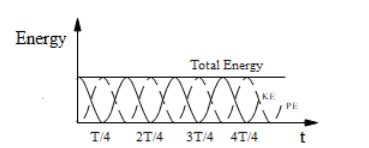
The particle executing simple harmonic motion has a kinetic energy ${{\text{K}}_{\text{0}}}\text{co}{{\text{s}}^{\text{2}}}\text{ }\!\!\omega\!\!\text{ t}$. The maximum values of the potential energy and the total energy are respectively:
(A). ${{\text{K}}_{\text{0}}}$and ${{\text{K}}_{\text{0}}}$
(B). 0 and 2${{\text{K}}_{\text{0}}}$
(C). $\dfrac{{{\text{K}}_{\text{0}}}}{\text{2}}$and ${{\text{K}}_{\text{0}}}$
(D). ${{\text{K}}_{\text{0}}}$and 2${{\text{K}}_{\text{0}}}$
Answer
586.8k+ views
Hint: To answer this question, we have to take into consideration the energy inside the particles, while they are in simple harmonic motion. The energy that we will take into consideration should be at two positions. These positions are when the particles pass through the mean position and when they pass through the extreme position. On the basis of this the equations can be drawn.
Complete step by step answer:
We know that in case of a simple harmonic motion, the total energy of the particle is constant at every instant. This total energy is the entire kinetic energy when the particle is passing through the mean position and the total potential energy when the particle is passing through the extreme position.

In the above figure, the Potential Energy and the Kinetic Energy along with the time is shown. The dotted parabolic curve represents the Potential Energy and the solid parabolic curve represents the Kinetic Energy.
From the above diagram, we have an idea about the maximum values of the total Kinetic Energy and Potential Energy. So, as we can see that the maximum values of the total energy of Kinetic Energy and Potential Energy are equal.
Let us consider the total Kinetic Energy is ${{\text{E}}_{\text{K}}}$and the total Potential Energy is ${{\text{E}}_{\text{P}}}$.
So now we can write that,
${{\text{E}}_{\text{K}}}$= ${{\text{K}}_{\text{0}}}\text{co}{{\text{s}}^{\text{2}}}\text{ }\!\!\omega\!\!\text{ t}$
So from the above equation we can say that, the maximum of total kinetic energy or ${{\text{(}{{\text{E}}_{\text{k}}}\text{)}}_{\text{max}}}$= ${{\text{K}}_{\text{0}}}$.
Now moving on to the Potential Energy.
The total potential energy or ${{\text{(}{{\text{E}}_{\text{p}}}\text{)}}_{\text{max}}}$= ${{\text{K}}_{\text{0}}}$.
So considering both the equations of the total kinetic energy and the total potential energy we can write that,
Total Energy or ${{\text{(E)}}_{\text{total}}}$= ${{\text{K}}_{\text{0}}}$.
Hence, the maximum values of potential energy and total energy are ${{\text{K}}_{\text{0}}}$ and ${{\text{K}}_{\text{0}}}$respectively.
So, the correct answer is Option A.
Note: We need to keep in mind the formulas of potential and kinetic energy to find the total energy of the particles under simple harmonic motion. The total energy of the particles performing simple harmonic motion possess the same energy at any point of time. If the kinetic energy increases, the potential energy decreases and vice versa, keeping the total energy constant at any point.
Complete step by step answer:
We know that in case of a simple harmonic motion, the total energy of the particle is constant at every instant. This total energy is the entire kinetic energy when the particle is passing through the mean position and the total potential energy when the particle is passing through the extreme position.

In the above figure, the Potential Energy and the Kinetic Energy along with the time is shown. The dotted parabolic curve represents the Potential Energy and the solid parabolic curve represents the Kinetic Energy.
From the above diagram, we have an idea about the maximum values of the total Kinetic Energy and Potential Energy. So, as we can see that the maximum values of the total energy of Kinetic Energy and Potential Energy are equal.
Let us consider the total Kinetic Energy is ${{\text{E}}_{\text{K}}}$and the total Potential Energy is ${{\text{E}}_{\text{P}}}$.
So now we can write that,
${{\text{E}}_{\text{K}}}$= ${{\text{K}}_{\text{0}}}\text{co}{{\text{s}}^{\text{2}}}\text{ }\!\!\omega\!\!\text{ t}$
So from the above equation we can say that, the maximum of total kinetic energy or ${{\text{(}{{\text{E}}_{\text{k}}}\text{)}}_{\text{max}}}$= ${{\text{K}}_{\text{0}}}$.
Now moving on to the Potential Energy.
The total potential energy or ${{\text{(}{{\text{E}}_{\text{p}}}\text{)}}_{\text{max}}}$= ${{\text{K}}_{\text{0}}}$.
So considering both the equations of the total kinetic energy and the total potential energy we can write that,
Total Energy or ${{\text{(E)}}_{\text{total}}}$= ${{\text{K}}_{\text{0}}}$.
Hence, the maximum values of potential energy and total energy are ${{\text{K}}_{\text{0}}}$ and ${{\text{K}}_{\text{0}}}$respectively.
So, the correct answer is Option A.
Note: We need to keep in mind the formulas of potential and kinetic energy to find the total energy of the particles under simple harmonic motion. The total energy of the particles performing simple harmonic motion possess the same energy at any point of time. If the kinetic energy increases, the potential energy decreases and vice versa, keeping the total energy constant at any point.
Recently Updated Pages
Master Class 12 Economics: Engaging Questions & Answers for Success

Master Class 12 Maths: Engaging Questions & Answers for Success

Master Class 12 Biology: Engaging Questions & Answers for Success

Master Class 12 Physics: Engaging Questions & Answers for Success

Master Class 8 Maths: Engaging Questions & Answers for Success

Class 8 Question and Answer - Your Ultimate Solutions Guide

Trending doubts
What is meant by exothermic and endothermic reactions class 11 chemistry CBSE

10 examples of friction in our daily life

One Metric ton is equal to kg A 10000 B 1000 C 100 class 11 physics CBSE

1 Quintal is equal to a 110 kg b 10 kg c 100kg d 1000 class 11 physics CBSE

Difference Between Prokaryotic Cells and Eukaryotic Cells

What are Quantum numbers Explain the quantum number class 11 chemistry CBSE




